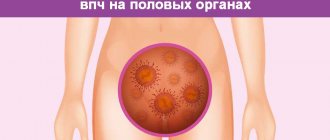Condylomas on the scrotum are considered a contagious skin disease that can be sexually transmitted. Due to the fact that the papilloma virus enters the human body, neoplasms develop on the genital organs, causing various kinds of anxiety, pain and physical discomfort.
With such problems, you should immediately contact a medical specialist, without starting the disease or trying to cope with it by self-medication. The situation can be aggravated if you do not consult a doctor in time and subsequently the treatment will be more difficult, expensive and lengthy. In general, it is possible to fight condylomas, although relapses of this disease are not uncommon.
Moles in an intimate place. Danger, Risks, Complications.
Intimate moles (nevi) are not only a kind of decoration of the body, but also a risk zone. This is due to the possibility of their malignancy. Moles on the labia in women or on the genitals in men are small and almost invisible. But convex formations can cause concern, as well as cause inconvenience and even pain during sexual intercourse. The size of intimate moles and their color may vary. Sometimes they are small, but they can also grow into birthmarks. There are black, brown, red moles, as well as flat and convex. Moles in intimate places can be congenital or acquired. Congenital nevi occur in the first year of a child’s life. Acquired ones arise during human life under the influence of various factors. There is nothing dangerous about birthmarks on the genitals themselves. Unfortunately, the danger is posed by the fact that under the influence of certain factors, a mole can begin to change and turn into melanoma and cost a man or woman not only his health, but also his life.
Statistics
Due to the anatomical features of the veins in the testicular area, varicocele most often forms on the left side. 80-95% are allocated to these cases. Right-sided testicular varicose veins are not so common (up to 8%). On both sides, varicocele occurs in 2-12 cases out of a hundred. Male disease is “linked” to the age of the patients. A large percentage (19) of problems with testicular veins are noted by doctors in adolescents. If we consider the reproductive age of men, then the statistics of varicose veins reach 35%. These are sad numbers, because... Varicocele in sexually mature men can cause infertility. Treatment of the disease should begin at the earliest stages.
Reasons for the appearance of moles in intimate places in men:
If a man has a mole on the penis that has a convex shape or is located on a thin stalk (a hanging mole), it is necessary to get rid of the pigment as soon as possible. Its risk of injury can lead to degeneration from a benign to a malignant formation.
- Frequent visits to the solarium. Regular use of a solarium before the age of 35 increases the risk of melanoma, the most aggressive type of skin cancer, by 75%, the American Center for Disease Control and Prevention (CDC) reports on its official website;
- Constantly wearing underwear in the form of swimming trunks. Such underwear rubs and compresses the genitals, and constantly slightly injures the skin. For a man accustomed to these sensations, it may not be noticeable, but the skin suffers;
- Accidental injury to the skin on the penis or the head of the penis can lead to the formation of a nevus. Injuries or microtraumas can happen anywhere and for any reason: excessively harsh washing, unsuccessful sex, a sharply buttoned fly;
- Regularly being under stress or chronic diseases can trigger the appearance of moles in intimate places;
- Frequent visits to the radiologist or long stay in an area of increased radiation;
- Transitional age, during which hormonal imbalance occurs;
- The presence of viral or infectious diseases of the genital area.
Varicocele. Symptoms
The danger of the first stages of the disease is that it is asymptomatic. The problem is discovered by chance, during medical examinations or when patients address other male issues (for example, in connection with infertility). Symptoms of varicocele characteristic of other degrees of the disease:
- nagging pain and discomfort in the left side of the scrotum, testicle and groin area;
- drooping left (mostly) testicle, interfering with walking;
- decrease in the size of the testicle on the left;
- manifestation of the contours of venous vessels;
- appearance of pain.
Varicocele is characterized by symptoms manifested in a decrease in the number of sperm and a decrease in their motility, in this case it is worth talking about male infertility. When doctors try to find out the cause of male infertility and analyze various symptoms in a patient, they often discover a varicocele, using the most modern diagnostic methods.
Reasons for the appearance of moles in a woman’s intimate places:
- Frequent trips to the solarium, prolonged exposure to direct sunlight. The WHO health organization equates solariums in terms of their harmfulness to cigarettes and alcohol. WHO has concluded that the risk of cancer from the use of tanning beds should be considered not “possible”, but “maximum”;
- Ultraviolet radiation - its excessive exposure promotes increased production of melanin, which provokes the appearance of nevi on different parts of the body or the growth of existing ones;
- Changes in hormonal levels - changes in hormone levels in women during puberty, when taking contraceptive medications or during pregnancy;
- Weakening of the general immune defense of the body (prolonged colds and infectious diseases, vitamin deficiency, congenital or acquired immunodeficiencies);
- Genetic predisposition - pigmented neoplasms are formed during the period of intrauterine development of the fetus;
- Neglect of basic hygiene rules, use of allergenic products for intimate hygiene;
- Diseases of the pancreas, gastrointestinal tract or liver also affect the appearance of skin tumors;
- Prolonged psycho-emotional tension, stress and shock;
- Infectious and inflammatory processes of the genital area;
- Metabolic disorders (in particular lipid metabolism);
- Congenital pathologies of skin pigmentation;
- Physiological characteristics of a woman’s body;
- Frequent and prolonged hypothermia;
- Pathologies of the cardiovascular system.
Moles on the labia or genitals in men must be distinguished from condylomas and warts, which can be a symptom of a sexually transmitted disease. Nevi that are regularly injured can provoke an oncological process. For example, convex or hanging growths cling to clothing or are injured during intimacy. In most cases, such pigmented formations are benign, but under the influence of a number of factors they can degenerate into melanoma. If a mole has sharply increased in size, its color or shape has changed, pain, cracks have appeared, or an inflammatory process has begun, then you need to consult an oncologist. In this case, surgical intervention is indicated to prevent their malignancy. For women, moles on the labia can cause huge problems, as they are easily damaged during shaving and hair removal: A mole on the labia, at first glance, is a highlight of a woman, but it can cause many problems and inconveniences. Such a formation does not always look aesthetically pleasing, but the most dangerous thing is that it can degenerate into a malignant tumor. All nevi must be monitored so as not to miss this process. A mole in an intimate place, especially if it is convex in shape, can cause considerable inconvenience and trouble to its owner. Many women are very worried about a mole on the labia or possible health complications associated with it, and are afraid of damaging it in some way.
History of the disease
Varicocele is a disease with deep historical roots. The first mention of the problem dates back to the 16th century and is associated with the name of Paré, a famous surgeon of the Renaissance. He drew attention to the pathology of the venous vessels near the male testicle. Many medical historians speak of the involvement of Hippocrates and Celsius in establishing the facts about this problem. The topic of varicocele is very closely related to infertility. In the 19th and 20th centuries, scientists confirmed the possibility of curing male infertility in direct proportion to the elimination of testicular varicose veins.
When to see a doctor:
- Takes on a bright red or almost black color;
- Bleeds, peels, itches, cracks appear;
- Causes pain during sexual intercourse;
- It causes inconvenience and there is a risk of damage;
- It has uneven edges and an asymmetrical shape;
- A red rim appeared around the mole;
- Has dimensions greater than 6 mm;
- Increases in size.
Such moles require special attention and mandatory consultation with a doctor, regardless of whether they are located in the intimate area or on any other part of the body. According to research, it has become known that approximately 50% of intimate moles develop into melanoma. Therefore, every birthmark needs to be monitored.
Important! Melanoma is a malignant neoplasm. To treat melanoma, you need to see an oncologist. Modern medicine has developed ways to remove almost any mole. However, it is worth consulting with a doctor in advance, getting tested for tumor markers, and also doing a biopsy of the tumor to determine whether it is benign or malignant.
Diagnostics
The doctor evaluates the clinical picture and prescribes instrumental and laboratory tests:
- microscopic analysis of a preparation of scales;
- bacteriological culture;
- polymerase chain reaction;
- Wood's lamp examination.
During the differential diagnosis, the venereologist excludes pathologies such as erythrasma, neurodermatitis, herpes virus, allergic and seborrheic dermatitis, candidiasis.
The Center for Urology, Gynecology and Reproductology in Moscow carries out laboratory and differential diagnosis of inguinal epidermophytosis with further treatment.
Mole removal methods:
Surgical removal of moles.
- Although surgical removal of formations is safe, it still has some disadvantages:
- After removing a mole, you need to avoid contact with ultraviolet radiation for a certain period of time;
- Long period of rehabilitation and healing of the wound after removal of the formation;
- The risk of noticeable scars and keloids appearing at the site of the former mole.
Cryodestruction.
- The inability to conduct a histological examination of the removed material, which increases the risk of not finding out about melanoma or skin cancer in time;
- The spread of liquid nitrogen is unpredictable; the nevus may not be completely removed, which means repeated removal will be required;
- It is difficult to predict the area of distribution of liquid nitrogen and there is a possibility of damage to healthy tissues by cold;
- This procedure is suitable for removing moles in visible places;
- This method is used mainly for small formations;
- The need for many repeated procedures;
- High risk of infection.
- The disadvantages of cryodestruction are quite significant, so before removal by this method, you should carefully weigh the pros and cons.
Electrocoagulation.
- the need to use local anesthesia, since the procedure is accompanied by pain; the need to treat the wound after surgery; the thermal effect extends to nearby areas of the skin;
- in some cases, a scar remains on the treated area; the possibility of an allergic reaction to local anesthesia;
- the need for repeated procedures;
- possibility of infection;
- allergic reaction to cold.
Radio wave removal of moles.
- when removing a large nevus, scar formation is possible;
- inability to remove large moles;
Laser removal of moles.
- The laser method of removing benign tumors is considered today the most painless, low-traumatic and effective method, which is popular all over the world.
- At the same time, the laser does not leave scars on the skin, and also eliminates pigmentation.
- There is no bleeding during or after the procedure.
- The effectiveness of the laser is due to the small diameter of its beam, high accuracy and the ability to fully control the depth of impact.
- After this procedure, the recovery process is very fast, due to the ability of the laser to stimulate the regeneration of skin cells.
- The only disadvantage of laser mole removal is the relatively high cost of removal.
Laser removal of intimate moles in the laser surgery room “LaserMedChisinau”! Today, the safest and most effective method of getting rid of unwanted moles is laser mole removal, during which layers of the mole are removed one by one. Anesthesia is usually not used. Thanks to the latest technologies, the highest precision in mole removal is achieved without damaging adjacent healthy tissue. The diameter of the laser beam can be adjusted with the highest precision, and it is also possible to select the optimal depth of exposure.
Preparation for laser removal of intimate moles in the laser surgery office “LaserMedChisinau”! Preparation for the procedure: no special preparation is required. It is not recommended to remove tumors (removal of moles, warts, papillomas, etc.)
- with photodermatosis – allergy to sunlight;
- women during menstruation;
- immunodeficiency states;
- oncological diseases;
- elevated temperature;
- inflammation of the skin;
- diabetes
- pregnancy;
- epilepsy;
- herpes;
- acne.
In the laser surgery office "LaserMedchisinau", the patient undergoes laser removal of moles only after a preliminary consultation with a licensed medical specialist - oncologist (for example: Doctor Victor Ciuperca, şeful secţiei Tumori Piele şi Melanom, IMSP Institutul Oncologic, Moldova or any licensed oncologist) with the issuance of an advisory opinion, which you must have with you. After consultation, a licensed medical specialist - oncologist issues an advisory opinion for the doctors of the medical institution at the patient’s place of residence.
Treatment
To the question of how to treat papillomas in intimate places , modern medicine gives a clear answer: they need to be removed. Destruction of benign neoplasms can be carried out using various methods:
- electrocoagulation – exposure to high frequency current;
- cryodestruction - removal using cold treatment;
- laser removal – layer-by-layer treatment with laser radiation;
- chemical destruction - using special chemical solutions.
Classic surgical removal is also an option.
A specific scheme for how to completely and safely remove papillomas in intimate places is prescribed by a specialist in accordance with the localization of the process, the severity of the course, and concomitant diseases.
An important aspect of treating papillomas in intimate places is changing lifestyle and strengthening the immune system. An integrated approach avoids the emergence of new formations.
Advantages of laser removal of moles in the laser surgery office “LaserMedChisinau”:
- Laser removal of skin defects, such as moles, is carried out using the most modern and high-tech laser equipment of the latest generation based on a CO2 laser;
- No relapses - moles no longer appear in the old place;
- Fast recovery and short rehabilitation period;
- The operation is painless, fast and without bleeding;
- Healthy tissue around the nevus remains intact;
- No noticeable scars or scars after surgery;
- You can remove several nevi at once in one session;
- Absence of various inflammatory processes;
- The operation is performed on an outpatient basis.
- Precise removal of the deepest part of the mole;
- Neighboring skin areas are not damaged.
Urologists
Erkov Igor Viktorovich Urologist andrologist
Cost of admission 2500
₽
Make an appointment
Fomenko Alexander Pavlovich Urologist andrologist
Cost of admission 2500
₽
Make an appointment
Recommendations after removal of intimate moles:
- You will have to avoid sexual intercourse for at least 7 days, as there is a risk of bleeding;
- Under no circumstances should the crust at the site of the removed mole be torn off, nor should it be wetted or lubricated with cream, iodine, or brilliant green;
- Only those drugs prescribed by the doctor are used;
- You cannot visit the pool, sauna or sunbathe;
- It is necessary to wear only loose underwear and clothing so as not to rub the mole removal site;
- Fabrics must be natural.
In the laser surgery office “LaserMedchisinau”, the patient undergoes laser removal of moles only after a preliminary consultation with a licensed medical specialist - oncologist (for example: Doctor Victor Ciuperca, şeful secţiei Tumori Piele şi Melanom, IMSP Institutul Oncologic, Moldova or any licensed oncologist) with the issuance of an advisory opinion, which you must have with you. After consultation, a licensed medical specialist - oncologist issues an advisory opinion for the doctors of the medical institution at the patient’s place of residence.
Laser mole removal is not only an excellent aesthetic solution for getting rid of unwanted intimate moles, but also the prevention of malignant skin diseases.
What does it look like
A photo of a varicocele clearly demonstrates a male problem - the scrotum on one side (usually the left) is slightly lower. The skin covering the testicle does not hide the contours of the veins. When self-palpating the venous vessels, a man can feel their expansion. The patient may not even be aware of other symptoms of the disease. Palpation of the scrotum and visual examination are necessary actions for all men who care about their health. This is especially true for males planning fatherhood. You need to be regularly examined by a urologist. Medical examinations and consultations with qualified specialists are offered by the Global Clinic Center, which has extensive experience in the treatment of varicocele.








